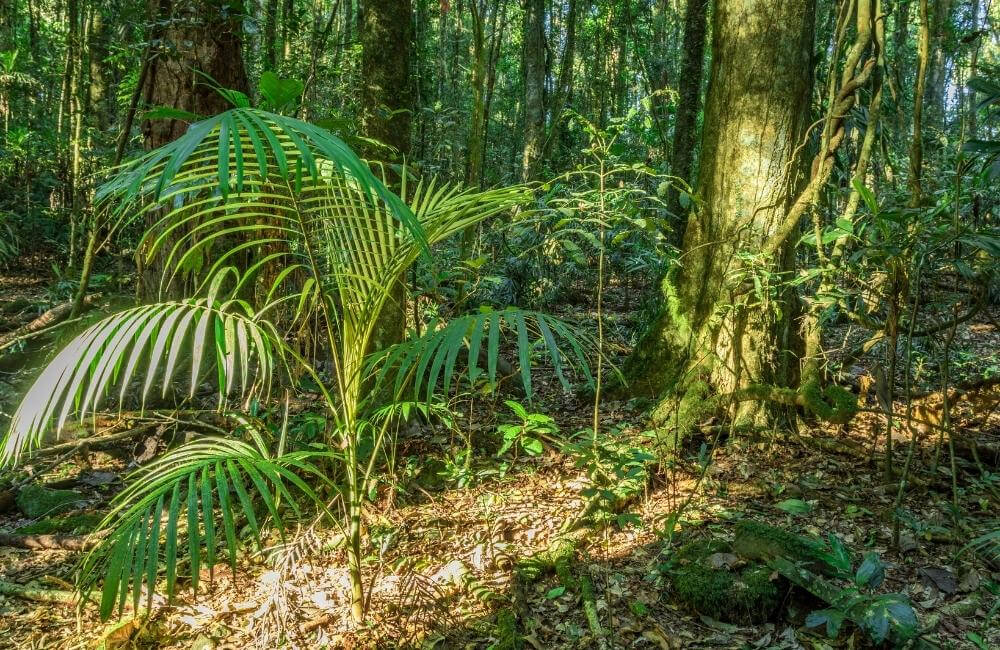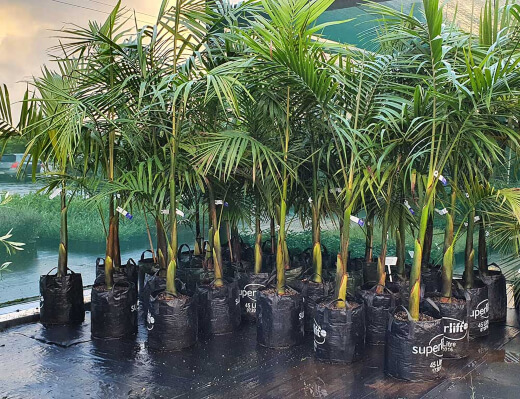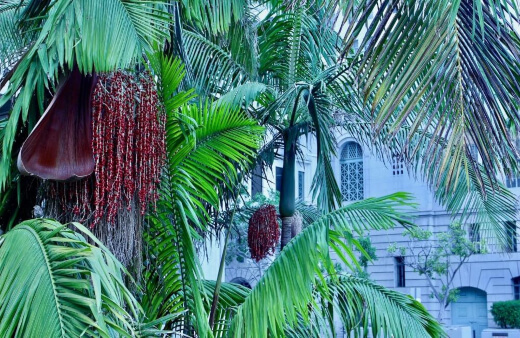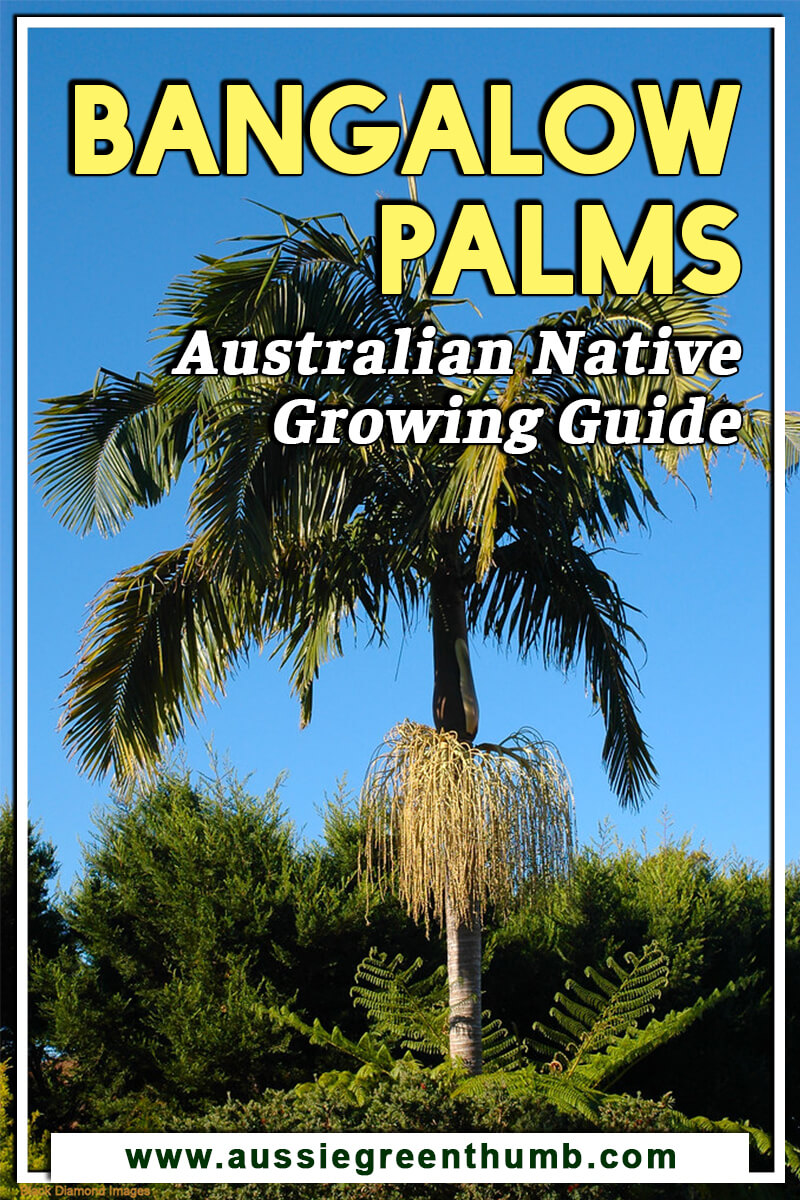Australia is home to over fifty known species of palms, which flourish in our tropical and subtropical areas. Bangalow palms are one of the fastest-growing types of palm tree. If you’re keen to have a tropical feel to your garden, you won’t have to wait very long to see this tree grow.
Many palm varieties can be difficult to establish. The Archontophoenix cunninghamiana (Bangalow palms) is perfect for any garden landscape because it’s superior in the way it grows compared to other palms.
More...
What are Bangalow Palms?

Archontophoenix cunninghamiana has bright green leaves and a thin trunk. It looks a bit top heavy – like it might fall over because the leaves are too heavy for the trunk below.
The Bangalow palm provides a lovely canopy and great shade. Bring on the cocktails.
Where are Bangalow Palm Native to?
Bangalow palm belongs to the Australian rainforest environment from central Queensland to Victoria and is often chosen as a backdrop for a domestic rainforest garden.
It grows in colonies in wet areas like stream banks and gullies in rainforest, moist forests and in swampy areas. It can grow on a variety of soil types and even grows in sand on Fraser Island.
Name Meaning and Nicknames
Some of the other common names for the Bangalow palm are:
- King palm
- Illawarra palm
- Piccabeen
Archontophoenix is from the Greek 'archon' or 'archontos' meaning 'ruler', referring to its stately appearance. The word 'phoenix' is in reference to the date palm.
Cunninghamiana is named after Allan Cunningham. He was a British botanist who worked extensively in Australia and sent some of the earliest specimens to The Royal Botanic Gardens.
Height and Depth
If you're looking for a tall addition to your garden, the Bangalow palm is the perfect choice. It can grow up to 25 metres high and several metres wide at the top.
The roots of the Bangalow palm are shallow. This makes it safe to plant near buildings or drainage pipes without worrying that the roots are going to attack the structures.
You can plant them in a row in a driveway for example, which makes a lovely feature. Just be sure to leave enough space between the palms for good circulation.
Climate Considerations
Bangalow palms require warm to relatively mild conditions to grow well outdoors. If you live somewhere with a cooler to moderately cold climate, that will also do. It handles cold temperatures better than some other palms.
Bangalow palms are also suitable for pots and will grow in most regions of Australia, except southern Australia and any frost-prone areas.


Get Your Free Guide:
Master Growing Australian Natives eBook
A Must Have Complete Guide for Every Australian Garden
Get Your Free Guide:
Master Growing Australian Natives eBook
A Must Have Complete Guide for Every Australian Garden
Special features of Archontophoenix cunninghamiana

Source: awanursery.co.nz
This palm shows off new leaves in shades of pink-red. From spring to summer, dark purple flowers grow out from the top of the trunk and develop into small green fruits which ripen to bright red in late summer to autumn. These are very appealing to bird life.
The fronds of Archontophoenix cunninghamiana have a slight silvery tinge to them, which are a beautiful contrast to other green palms.
In the warmer parts of Australia, the Bangalow palm produces flowers and fruit all year round. It flowers in either summer, or autumn as you move further down the East Coast. If the growing season is not warm enough, it may not flower at all.
Growing Bangalow Palms

Source: awanursery.co.nz
If you want a Bangalow palm in your garden, growing it from seed is your best option. Palm trees grow in a way that makes it impossible to propagate them through cuttings or division.
You can buy the seeds but can also get them from the seed pods of flowering Bangalow palms. The pods are the balls that form near the flowers and contain the palm seeds. Aim to collect seed when the fruit is completely ripe or when it falls from the tree.
It’s best to use the harvested seeds quickly. A good test to check if a seed is viable and can germinate, is to drop it in a container of warm water. If it floats, don’t use it. If it sinks, it’s fine.
Bangalow palm tree seed germination is fairly quick – 1 to 3 months. Most palms take 100 days or more to germinate. Before you plant the seed, you need to remove the exterior of the seed pod. Scrape off the fruit until just the seed is left.
If you are only planting bangalow palms with a few seeds, soak the seeds for a few days in water. You can then cut the fruit tissue away with a knife. Plant each seed in a small container, covering it with a thin layer or you can half bury it.
In nature, palm seeds are spread by the wind and animals and germinate on top of the soil. You need to keep the pots in a warm and humid place.
A good trick is to wrap the pot in a plastic bag, which holds in the moisture. You basically need to keep the soil moist and wait.
Bangalow Palm Care Guide

Source: coastpalms.co.nz
Sunlight
When the palm is young, it will be fine with partial sunlight. As it gets older and taller, it will need full sun exposure.
Watering Bangalow Palms
The Bangalow palm is quite thirsty. It needs a lot of water and a lot of moisture in its soil to stay healthy. If you live in a warmer city, you'll need to keep a close eye on its water needs. Hot and high temperatures affect the Bangalow palm’s growth and they don’t cope with excessively hot weather.
You need to water the palm in such a way that the water penetrates the roots. As the Bangalow palm grows, you can water it less. Palms aged between 1-2 years need to be watered 3 to 4 times a week while a tree aged 3-4 years would need watering 2 to 3 times weekly.
Hydrophobic soil is a common issue in Australia – if you’re concerned about your soil health, here are some solutions on the market, including our list of recommended soil wetting agents.
How to Prune Bangalow Palms
Compared to other palms, the Bangalow palm is a low-maintenance plant. It sheds and removes dead leaves by itself, which means no regular pruning required.
If only a few leaves have turned brown and new foliage is still growing, then you don’t need to worry. You might want to prune to maintain the lovely green foliage though. Here’s how to do it:
- Have your pruning shears or sharp scissors ready, along with paper towel and rubbing alcohol
- Wipe the blades of the pruning shears with alcohol and wet them with water before cutting to avoid tissue damage
- Any leaves that are completely yellow or brown can be cut at the base. If the leaf is only slightly yellow or brown, then cut the affected area.
If you’re in the market for a pruning saw, have a look at our pruning saw buying guide where we rate our top 5 products that we would highly recommend.
Fertilising
The Bangalow palm is so adaptable and can grow in a range of soil types. It does enjoy soil rich in organic matter though. Bangalow palms do need a fertiliser application about 3 to 4 times a year to help their growth.
The fertiliser you use should include nitrogen, potassium, magnesium, and phosphorus and should be a palm specific fertiliser. Get to know more about fertilisers with our complete Australian garden fertiliser users guide.
Diseases that Affect the Bangalow Palm

Here are some of the diseases that could affect Bangalow palms and some advice on how to treat them.
Bud Rot
This attacks the fronds of the palm. It is a type of fungus that causes the fronds to shrivel up and die. Summer is the biggest challenge, as this is the season when Bud Rot is most likely to happen.
It can be treated by applying chemicals to the palm – this is possible if the disease is still in its early stage. It’s best to consult a specialist, and to avoid spreading fungi, be sure to sterilise your gardening tools.
Fusarium Wilt
This is another palm disease caused by fungus. Once it sets in, the palm fronds will lose their green colour and start to wilt, with the fungus killing them in the process.
Unfortunately, Fusarium Wilt is a deadly disease and causes permanent damage to the Bangalow palm. Once it has been infected, there is no cure and the infected plant will have to be removed to prevent fungi spores from spreading.
Ganoderma Rot
Ganoderma Rot is a fairly recent discovery. It actually originated in Florida and has spread to other parts of the world. This disease is caused by the fungus Ganoderma Zonatum which enters the palm through a wound in the trunk area.
It moves quickly into the palm and rots the wood. Once the fungus gets to the centre of the palm, it forms a spongy, white growth that looks like mushrooms and is called a "conk". It forms a horizontal disk on the bark of the palm.
It is unfortunate that there is no known treatment for this disease. If you see the "conk" on the bark of the palm, it sadly means time is up for the tree.
You will need to remove it immediately from the area to avoid infecting other palms nearby. Sterilise all your tools after working with the infected Bangalow palm, and wash your gloves and clothes well too.
Frequently Asked Questions About Bangalow Palms

What is the bangalow palm used for?
The leaf bases of the Bangalow palm were used to carry water by Aboriginal people. The names Piccabeen and Bangalow apparently come from Aboriginal words for water carrier.
The cabbage, which is the shoot with its young leaves and tissue, can be eaten and was collected by Aboriginal people and early settlers.
Is the bangalow palm native to Australia?
Bangalow palm (Archontophoenix cunninghamiana) is a native palm tree from the rainforests of the east coast of Australia, from Queensland to New South Wales.
Is bangalow palm an indoor plant?
The Bangalow palm, because it is tall and slender, is appealing as an ornamental plant for both the garden and indoors.
Are bangalow palm roots invasive?
The roots of this palm are shallow, meaning they don’t cause damage to other plants or structures. They can safely be planted around a pool for example, adding a tropical feel without worrying that the roots are going to cause destruction.
Are bangalow palms self-cleaning?
A self-cleaning palm means that the older, dead palm fronds will fall cleanly off the trunk without any intervention. Other examples of self-cleaning palms are the Royal palm, Foxtail palm, Alexander palm and Christmas palm .
Not many things in life are self-cleaning, so having a palm that takes care of itself is a bonus.
Also, you consider composting palm fronds if you prefer to make your own compost.
Can you transplant a bangalow palm?
This palm does not like root disturbance and can be difficult to transplant successfully.
Are there any pests that affect the bangalow palm?
Palm Dart butterfly larvae, scale insects and mealybugs are the enemy as they make the fronds look ragged. These can be easily dealt with using an insecticide spray.
Are you looking for other palm trees to grow in your garden? See more of our palm tree growing guides below:

Transform Your garden with the Elegance of Bangalow Palm
The Bangalow palm is robust and easy to grow. If you’re looking for an elegant palm that is fast growing and adds a tropical feel to your space, this is a good choice.
It can be indoors or outdoors, produces beautiful red seeds as a mature tree and is self-cleaning (that alone is a selling point). Oh did we also mention that the Bangalow palm is generally drought tolerant?
We’re giving the Bangalow palm our thumbs up!
Published on February 26, 2022 by Nathan Schwartz
Last Updated on January 18, 2025





We had to have Bangalow Palm cut down as it the trunk was forcing a lean on the front fence and it had grown so tall it was not affective in shading the area it covered when younger. The trunk is still in the ground, slowly decaying but the seeds , which were plentiful and never a problem are now shooting in their hundreds. I would not recommend it as a tree suitable for a suburban garden . Too tall and time-consuming, I every day having to dig up the new seed shoots which pop up constantly. Pretty when young but 25 years on was so high it affected power lines as well.
Hey Margaret, thank you for sharing your experience.
With the new shoots sprouting up this will be from the roots of your bangalow palm and not from the seeds. It will rejunvenate new stes and shoots from the roots as it is still a healthy, living tree and will do what it can to survive.
The best way to prevent this is to remove the palm completely and most of it’s roots which we be a hard dense mass around the base of the palm.
Cheers,
Nathan
I get lots of flowers but never any seeds. I love the look of cascading red seeds and wondered if you have any advice.
Hi Jennifer
Bangalow Palms usually start producing seeds or fruit annually once they have reached maturity and this usually follows after flowering. It can take around 5 years for the Bangalow Palm to establish itself, but it does depend on the growing conditions as they tend to grow more slowly in cooler weather.
Palm trees go through a reproductive process that then creates seed pods or fruit. If your plant is already established, and you are following the guidelines for Bangalow Palm care, perhaps speak to your local nursery for advice on how to help your plant to produce seed.
Best regards,
Gary Clarke